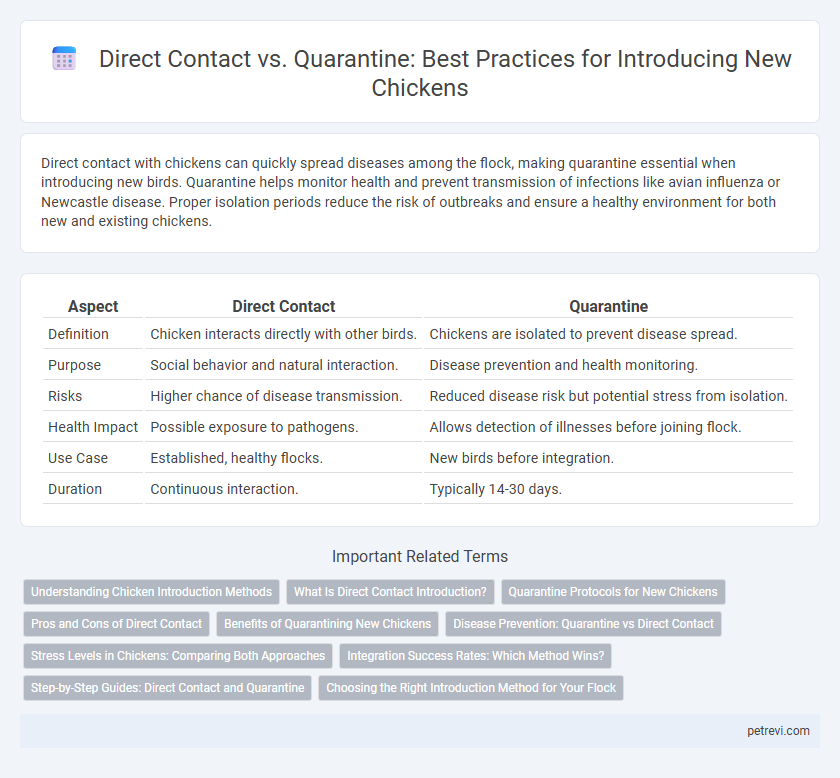Direct contact with chickens can quickly spread diseases among the flock, making quarantine essential when introducing new birds. Quarantine helps monitor health and prevent transmission of infections like avian influenza or Newcastle disease. Proper isolation periods reduce the risk of outbreaks and ensure a healthy environment for both new and existing chickens.
Table of Comparison
| Aspect | Direct Contact | Quarantine |
|---|---|---|
| Definition | Chicken interacts directly with other birds. | Chickens are isolated to prevent disease spread. |
| Purpose | Social behavior and natural interaction. | Disease prevention and health monitoring. |
| Risks | Higher chance of disease transmission. | Reduced disease risk but potential stress from isolation. |
| Health Impact | Possible exposure to pathogens. | Allows detection of illnesses before joining flock. |
| Use Case | Established, healthy flocks. | New birds before integration. |
| Duration | Continuous interaction. | Typically 14-30 days. |
Understanding Chicken Introduction Methods
Direct contact introduction involves placing new chickens directly with the existing flock to promote immediate socialization and natural behavior, but it carries a high risk of disease transmission. Quarantine introduction requires isolating new chickens for 2 to 4 weeks in a separate area to monitor health and prevent potential illnesses from spreading to the main flock. Proper quarantine practices include observing for symptoms, disinfecting equipment, and gradually acclimating chickens to their new environment before mixing.
What Is Direct Contact Introduction?
Direct contact introduction in chickens involves placing a new bird directly with the existing flock, allowing immediate physical interaction for natural social integration and disease exposure assessment. This method enables rapid establishment of the pecking order and can help boost immunity by controlled exposure to flock-specific microbes. However, it carries risks of transmitting contagious diseases without the protective period a quarantine provides.
Quarantine Protocols for New Chickens
Quarantine protocols for new chickens typically involve isolating birds for a minimum of 30 days to prevent the spread of diseases such as avian influenza and Newcastle disease. Direct contact between new and existing flocks can facilitate the transmission of pathogens, making quarantine essential for monitoring symptoms and maintaining flock health. Implementing strict quarantine measures, including separate housing and dedicated equipment, minimizes the risk of infection and supports biosecurity in poultry management.
Pros and Cons of Direct Contact
Direct contact in chicken management enables natural social behaviors and quicker integration, promoting stronger flock cohesion and reducing stress. However, it increases the risk of disease transmission and complicates early detection of illnesses compared to quarantine measures. Despite these risks, direct contact remains essential for optimal growth and behavioral development in poultry farming.
Benefits of Quarantining New Chickens
Quarantining new chickens minimizes the risk of introducing diseases such as avian influenza and coccidiosis to the existing flock by isolating potential carriers for 30 days. This practice allows for monitoring symptoms and administering necessary treatments before integrating birds, ensuring flock health and reducing mortality rates. Direct contact without quarantine often leads to rapid spread of infections, compromising overall productivity and biosecurity.
Disease Prevention: Quarantine vs Direct Contact
Quarantine is essential in preventing disease transmission among chickens by isolating new or sick birds for a specific period, reducing the risk of direct contact with healthy flocks. Direct contact with infected chickens significantly increases the spread of pathogens such as avian influenza and Newcastle disease, making controlled interactions critical. Implementing strict quarantine protocols alongside biosecurity measures minimizes outbreaks and supports healthier poultry populations.
Stress Levels in Chickens: Comparing Both Approaches
Direct contact with other chickens often results in lower stress levels due to familiar social interactions and established pecking orders, promoting natural behaviors and reducing anxiety. Quarantine, while essential for disease control, can elevate stress responses because of isolation, unfamiliar environments, and the absence of social cues, negatively impacting immune function and overall well-being. Monitoring cortisol levels and behavioral changes provides measurable insights into the stress differences between direct contact and quarantine, guiding poultry management practices for healthier flocks.
Integration Success Rates: Which Method Wins?
Direct contact integration in chicken flocks often results in higher success rates due to immediate social bonding and natural behavior establishment, promoting stronger immunity and stress reduction. Quarantine methods, while essential for disease prevention, tend to delay social acclimation, potentially leading to increased aggression and lower integration success. Studies reveal that combining initial quarantine with controlled direct contact optimizes both health safety and integration success in poultry management.
Step-by-Step Guides: Direct Contact and Quarantine
Step-by-step guides for chicken health emphasize minimizing disease spread through direct contact and quarantine measures. Direct contact requires monitoring physical interactions among chickens to promptly isolate any showing illness signs, while quarantine involves a strict separation period for new or returning birds, usually lasting 30 days, to observe and prevent transmission of diseases. Effective implementation of these steps ensures flock health and reduces outbreaks by controlling exposure risks.
Choosing the Right Introduction Method for Your Flock
Choosing the right introduction method for your chicken flock involves weighing the benefits of direct contact against quarantine protocols to prevent disease spread. Introducing new chickens through quarantine allows careful observation for illness, reducing the risk of infection to existing birds. Direct contact introduction can speed integration if biosecurity measures and health screenings are thoroughly conducted prior.
Direct contact vs Quarantine for Chicken Introduction Infographic

 petrevi.com
petrevi.com